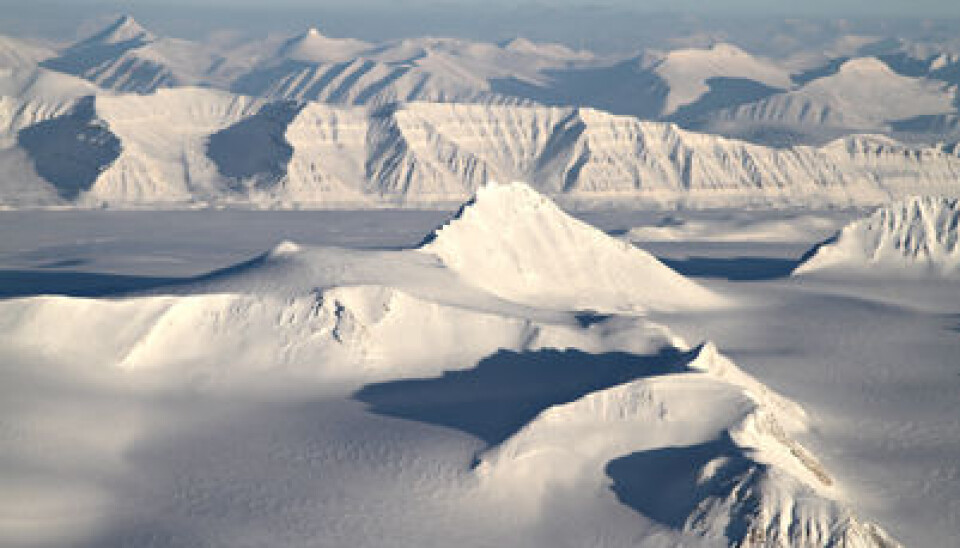
Why Svalbard is rising
OPINION: New measurements explain why the uplift of the Svalbard islands is larger than the models predict.
Denne artikkelen er over ti år gammel og kan inneholde utdatert informasjon.
The uplift measured at Ny-Ålesund in Svalbard reflects changes in the regional ice cover during the last Ice Age, after the Little Ice Age and today.
But the geodetic observatory operated in this Arctic settlement by the Norwegian Mapping Authority (NMA) has long shown the rise to be higher than predicted by geophysical modelling.
Comparing gravimetric readings with measurements by GPS and very long baseline interferometry (VLBI) makes it possible to understand the suprisingly large uplift in Svalbard and why this is so much bigger than the models predict.
At the moment, the uplift in Ny-Ålesund is about 8.5 millimetres per year. But this figure also varies considerably from year to year.

The latter correlates closely with current ice melting. Combining various measuring techniques makes it possible to separate out the various processes and thereby to say something about ice melting in the various periods.
Slow and rapid
When a lot of ice melts, the immediate consequence is rapid uplift of the crust – a quick elastic response. This comes to a halt when no ice is melting. The process has yielded an average rise of 3.3 millimetres per annum over the past 10 years.
Another component of uplift can be attributed to ice melting at the end of the last Ice Age. This is a slow process – a visco-elastic response, and movements of mass in the mantel are required for it to take place. The models suggest that this rise should be about 1.7 millimetres per annum in the area around Ny-Ålesund. In other words, the actual uplift is much higher than the models indicate.
Today’s elevation and elevation change is largely measured with the geodetic techniques GPS and VLBI. Both are deployed in Ny-Ålesund.
They are supplemented by gravimetric readings which measure gravitational changes with extreme accuracy.
Gravitational changes
Measurements of the Earth’s gravity and changes in it provide supplementary information on uplift. If one point rises, it will also move further from the Earth’s centre of mass and the force of gravity will decline. This is what a gravimeter measures.
Since a quick rise consists largely of height changes rather than movements in the Earth’s interior, the gravitational change can be derived simply by looking at the alterations in elevation.
Slow uplift, on the other hand, also leads to movements of mass in the mantle, which also change gravitational force. Measuring these changes in addition to elevation changes makes it possible to discover more about the underlying processes driving uplift.
Both gravitational and elevation measurements show large variations from year to year. These correspond with the expected outcome of rapid uplift caused by ice melting in the area. The melting of glacier ice near Ny-Ålesund is regularly measured by the Norwegian Polar Institute.
Little Ice Age
Looking at the whole series of measurements over 10 years, however, it can be seen that both uplift and gravitational changes are larger than expected. Comparing the variance from expectation for both gravity and elevation indicates that the underlying process involves movements of mass in the mantle.
In other words, we are probably dealing with a form of slow uplift. Models for the last Ice Age are unlikely to be so poor that this could explain the shortfall in uplift. The most probable reason for the excess uplift is ice changes in a later period.
Glaciers on Svalbard are known to have receded after the Little Ice Age, which ended in the islands around 1870. Further research will show whether this can really explain the whole variance between measured and calculated uplift.
Observatory contributes
The Norwegian Mapping Authority is planning to upgrade its geodetic observatory in Ny-Ålesund. This facility forms part of an international network of such stations and, with its unique location in the Arctic, ranks as perhaps the most important of these units. The observatory undertakes measurements to identify a number of different Earth observational parameters, including uplift.
The uplift measured at Ny-Ålesund reflects changes to ice volumes in the area during the last Ice Age, the Little Ice Age and today. By combining gravity and uplift, the various processes can be separated out. That in turn makes it possible to say something about ice melting in the various periods.
A good understanding of the geophysical processes on Svalbard is essential for optimum utilisation of the observatory at Ny-Ålesund and for using its results to draw conclusions about geophysical conditions and climate, both locally and globally.
































